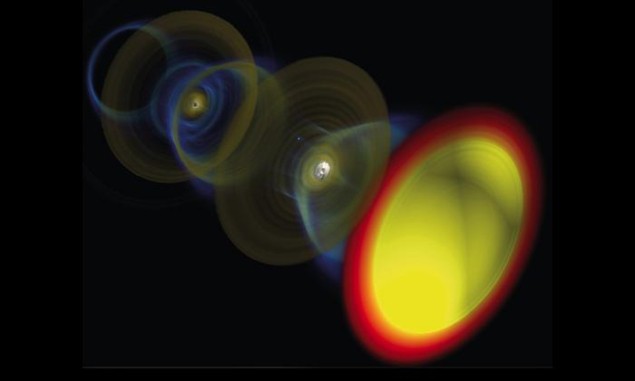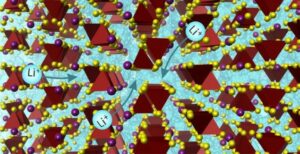
A proposed new light source based on plasma accelerators could make it possible to develop super-bright sources as powerful as the most advanced free-electron lasers – but much smaller. If demonstrated experimentally, the design put forward by an international consortium of researchers might be harnessed for a variety of applications, including non-destructive imaging and computer-chip manufacturing.
Coherent light sources such as free-electron lasers are routinely employed in academic research, where they are used to study the structure of biomolecules, the dynamics of chemical reactions and other puzzles in physics, chemistry and materials science. The problem is that they are huge: the most powerful, Stanford University’s Linac Coherent Light Source, is three kilometres long and driven by the Stanford Linear Accelerator (SLAC). Scaling them down would bring them within reach of smaller institutions such as universities, hospitals and industrial labs.
A “Mexican wave” for electrons
Researchers led by Jorge Vieira of the Instituto Superior Técnico (IST) in Portugal, together with John Palastro of the University of Rochester, US, think they’ve found a way of doing just that. Their design, which they developed with colleagues at the University of California, Los Angeles and the Laboratoire d’Optique Appliquée in France, calls for a powerful and bright laser source to be created using a collection of many electrons that move together like a single giant particle, or quasiparticle. “To picture what we mean by this, think of Mexican waves, which seem to go around the arena, even though each participating person stays put,” explains Bernardo Malaca, a PhD student at IST and first author of a study on the design published in Nature Photonics. “Such collective charged particle dynamics is at the heart of plasma physics.”
Just as a Mexican wave can, in principle, travel faster than the individual humans in the crowd (provided they all work together), Malaca says the same thing can happen with electrons. In that case, though, the consequences would be much more profound: “Mexican electron waves could travel faster than the speed of light, even though there isn’t a single electron locally that’s faster than light,” he explains.
When that happens, Malaca adds, the collective electron waves would radiate as if they were a single super-luminal electron. “The collective electron radiation can be pictured as if it originated from a single particle, raising the possibility of creating a hitherto unimagined class of temporally coherent sources,” he tells Physics World.
A quasiparticle version of the Cherenkov effect
In the new work, the researchers, who were supported by the European High-Performance Computing Joint Undertaking, used simulations on supercomputers to study the properties of quasiparticles in plasma. These simulations showed that radiation from a quasiparticle is indeed fundamentally indistinguishable from that produced by a single finite-sized particle.
The Portugal-US-France team also describe the physics of a quasiparticle version of the Cherenkov effect. Cherenkov radiation occurs when charged particles propagate through a medium at a speed that is faster than the speed of light in that medium. According to Einstein’s special theory of relativity, this effect cannot take place in vacuum, where the speed of light is fixed at just under 300 000 km/s. This limit does not apply to quasiparticles, however, which can travel at any velocity, including superluminal ones. “The quasiparticles can move in ways that would be disallowed by the laws of physics governing individual particles,” Palastro explains. “It is this absolute freedom to control the quasiparticle trajectory that may hold the key towards a new class of powerful yet compact light sources.”
Viera adds that quasiparticles may constructively combine the radiation from 1010 electrons. This, he notes, is “about the charge of an electron bunch at SLAC”.
One way to make a real-world light source out of quasiparticles would be to send an intense laser pulse or relativistic particle bunch into a plasma or gas where the density rises with distance, he adds. This configuration is known as a density up ramp and is standard in plasma-based accelerators. These, however, usually use a constant density profile. The new set-up would create a superluminal quasiparticle leading to quasiparticle-Cherenkov emission.
“To create an undulating quasiparticle, leading to undulatory radiation, we could send an intense laser pulse or relativistic particle bunch into a plasma or gas where the density varies periodically (sinusoidally) with distance,” explains Viera. “Different configurations are already available to create such profiles in the laboratory (for example, using the interference pattern between two ionising laser pulses, which ionise the plasma only in regions of constructive interference).
“An enormous impact”
If built and demonstrated in the laboratory, compact light sources based on quasiparticles could bring science and applications that are currently only possible in a few places around the world (as at the LCLS), Viera says. “Light sources have an enormous impact on our lives, from science and technology to everyday applications. For example, they play a crucial role in non-destructive imaging (like scanning for viruses or checking product quality), understanding biological processes (like photosynthesis), manufacturing computer chips and exploring the behaviour of matter in planets and stars.”

New particle accelerator is driven by curved laser beams
The researchers are now investigating ways of making quasiparticles radiate at other wavelengths of the electromagnetic spectrum. X-rays, for example, have wavelengths of around 1 nm, and would be particularly useful.
“We are also trying to experimentally demonstrate our concept,” Malaca says. “While being a conceptual innovation for the moment, we believe that the quasiparticle approach is simple enough to be tried out in dozens or even hundreds of labs around the world.”
- SEO Powered Content & PR Distribution. Get Amplified Today.
- PlatoData.Network Vertical Generative Ai. Empower Yourself. Access Here.
- PlatoAiStream. Web3 Intelligence. Knowledge Amplified. Access Here.
- PlatoESG. Carbon, CleanTech, Energy, Environment, Solar, Waste Management. Access Here.
- PlatoHealth. Biotech and Clinical Trials Intelligence. Access Here.
- Source: https://physicsworld.com/a/scientists-propose-super-bright-light-source-powered-by-quasiparticles/
- :is
- :not
- :where
- $UP
- 000
- 1
- a
- Absolute
- academic
- academic research
- accelerator
- accelerators
- According
- Adds
- advanced
- All
- already
- also
- an
- and
- any
- applications
- Apply
- approach
- ARE
- Arena
- around
- AS
- At
- author
- available
- based
- BE
- behaviour
- being
- believe
- between
- Bright
- bring
- built
- Bunch
- but
- by
- california
- Calls
- CAN
- cannot
- case
- charge
- charged
- checking
- chemical
- chemistry
- Chips
- class
- COHERENT
- colleagues
- collection
- Collective
- combine
- compact
- computer
- computing
- concept
- conceptual
- Configuration
- Consequences
- consortium
- constant
- constructive
- control
- could
- create
- created
- Creating
- crowd
- crucial
- Currently
- demonstrate
- demonstrated
- describe
- Design
- develop
- developed
- distance
- does
- doing
- down
- dozens
- driven
- dynamics
- each
- effect
- electrons
- emission
- employed
- enormous
- enough
- Europa
- European
- Even
- everyday
- example
- existence
- Explains
- Exploring
- faster
- few
- First
- fixed
- Flash
- For
- Forward
- found
- France
- Freedom
- from
- fundamentally
- GAS
- giant
- Go
- governing
- happen
- happens
- harnessed
- Have
- he
- Heart
- high-performance
- hold
- hospitals
- However
- http
- HTTPS
- huge
- Humans
- Hundreds
- if
- image
- Imaging
- Impact
- in
- Including
- indeed
- individual
- industrial
- information
- Innovation
- institutions
- Interference
- International
- into
- investigating
- issue
- IT
- joint
- jpg
- just
- Key
- known
- laboratory
- Labs
- laser
- lasers
- Laws
- leading
- Led
- light
- like
- LIMIT
- Lives
- locally
- Long
- los
- make
- Making
- manufacturing
- many
- materials
- Matter
- max-width
- May..
- mean
- medium
- might
- moment
- more
- most
- move
- much
- New
- Notes
- now
- of
- on
- ones
- only
- or
- originated
- Other
- our
- out
- participating
- particularly
- Pattern
- person
- phd
- Photosynthesis
- Physics
- Physics World
- picture
- Place
- Places
- Planets
- Plasma
- plato
- Plato Data Intelligence
- PlatoData
- Play
- Portugal
- possibility
- possible
- powered
- powerful
- principle
- Problem
- processes
- Produced
- Product
- Product Quality
- Profile
- Profiles
- profound
- properties
- propose
- proposed
- provided
- published
- pulse
- put
- Puzzles
- quality
- raising
- Ramp
- reach
- reactions
- real world
- regions
- relativity
- research
- researchers
- Rises
- Role
- routinely
- running
- same
- says
- scaling
- scanning
- Science
- Science and Technology
- scientists
- seem
- send
- showed
- Simple
- simulation
- single
- smaller
- Source
- Sources
- special
- Spectrum
- speed
- standard
- stanford
- Stars
- structure
- Student
- studied
- Study
- such
- superior
- Supported
- Take
- team
- Technology
- tells
- than
- that
- The
- the world
- their
- Them
- theory
- There.
- These
- they
- thing
- think
- this
- though?
- three
- Through
- thumbnail
- to
- today
- together
- towards
- trajectory
- travel
- tried
- true
- trying
- two
- ucla
- under
- understanding
- unique
- Universities
- us
- use
- used
- using
- usually
- Vacuum
- variety
- VeloCity
- version
- viruses
- Wave
- waves
- Way..
- ways
- we
- were
- What
- when
- which
- WHO
- with
- within
- Work
- work together
- world
- would
- yet
- zephyrnet













